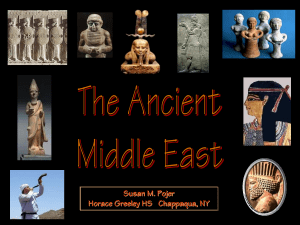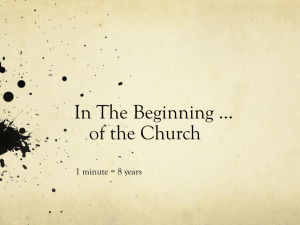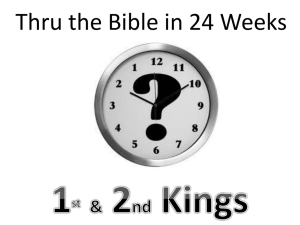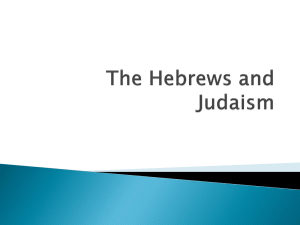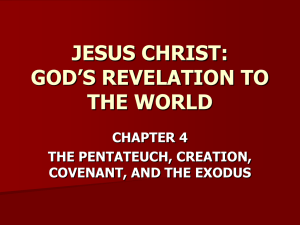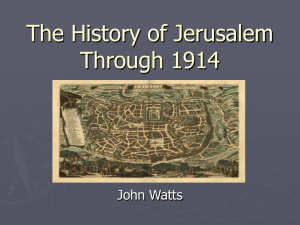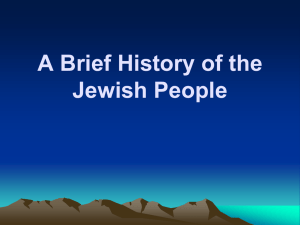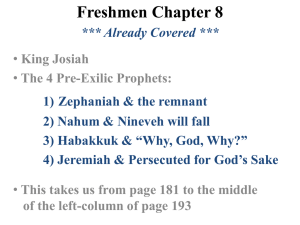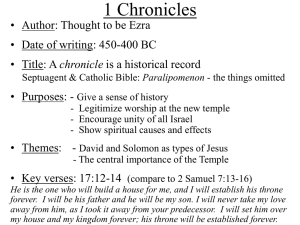NeoOffice Document
advertisement
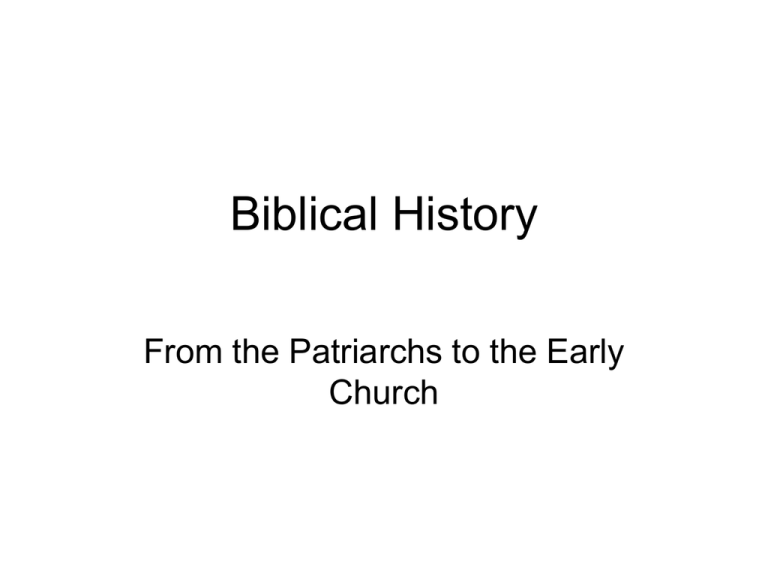
Biblical History From the Patriarchs to the Early Church 2100 B.C. – 1800 B.C. This is a picture of God appearing to Abraham stating the covenant. In the picture, God points to the stars indicating the many children (as many stars there are in the sky) he will have. Isaac was the only son of Abraham and Sarah. God spoke to Isaac, and reaffirmed that he would continue the covenant he made with Abraham. Isaac married Rebekah and had twins boys, Esau and Jacob. Esau was born first but Jacob was close behind. As a young man, Esau traded his birthright (right to the inheritance) to Jacob for some food. At 137 years old, Issac became completely blind, and blessed Jacob instead of Esau through Jacob’s trickery. Isaac dies not long after and was buried with his father and mother. God extends the Covenant he made with Abraham and Issac to Jacob. In this picture, Jacob is dreaming of a stairway to heaven. Here is a brief chart of the relationship between Abraham, Isaac, and Jacob. It is also a generation chart of their family. Jacob eventually fathered twelve boys and two girls. The boys, in turn, established tribes bearing their own names. Joseph Joseph was Jacob’s favourite son. His jealous brothers sold him into slavery in Egypt. There he prospered as a dream interpreter and eventually reunited with his family, who joined him in Egypt. Over time, the Hebrews grew in number. Eventually, a pharoah who did not know about Joseph made the Hebrews into slaves. They remained slaves for centuries. Moses and the Exodus 1450 B.C. God chose Moses, a Hebrew fugitive, to free the Hebrew slaves from Egypt. Moses led them through the Sea of Reeds to the Promised Land. On the way, God met Moses on Mt. Sinai and gave him 613 commandments. God wrote ten of them on two stone tablets. The commandments are the core of the Mosaic covenant. Moses built an ark (box) for the stone tablets. Ark of Covenant The Tabernacle of Moses Jerusalem and the Temple When they camped, the Israelites put the ark in the Tabernacle or tent. Priests sacrificed outside Jerusalem is the center of Jewish culture and religion and it the wastent. the location of the only Temple in all of Israel. The first house that was built for God was the Tabernacle of Moses which was a moveable tent. 1400-1000 B.C. In this period, the twelve tribes lived without a king but were united by their faith in God. Sometimes they lacked faith so God would punish them with invaders (usually Philistines). Later on, they would repent and then God would rescue them from the invaders by raising up a judge (a warrior judge) who would defeat the invaders. Samson The Strong Samson used his God-given Strength to saved the Israelites and killed many Philistines. By doing so, he ended the Philistine rule that had lasted for 40 years. Many Israelites looked up to him because he protect them from enemies. A Great Prophet Samuel was chosen to become a judge and prophet of God at a young age. He guided the Israelites toward God. Also, he resisted the petition of the people to have a king. Samuel asked God if a king was a good idea. God said it would ruin their way of life, but He let them do it. The United Kingdom (1000-922 B.C.) The first king was Saul, who started off well but then was rejected by God. The second king, David, was Israel’s greatest King. The 12 tribes had become divided by his time, but he reunited them. Solomon was David’s son. He replaced the tabernacle of Moses with a stone Temple in the city of Jerusalem. The Temple became the new home of the ark of the covenant. King David’s son King King David’s son King Solomon thought that God deserved a better place Solomon thought that God to live in then in a tent. That said King Solomon decided to build a hugeplace for deserved a better temple for God and the Ark of Covenant to live in. The his temple thronethat thenhein a tent. made was called the Temple of Solomon. That said, King Solomon decided to build a huge temple for God and the Ark of Covenant (his throne) to live in. The temple that he made was called the Temple of Solomon. The Fall of the Northern State 922 B.C. After the death of Solomon, the kingdom divided into two states: Israel in the north and Judah in the south. The northern king forced his people into worshiping a golden calf in two nothern cities in order to prevent his citizens from crossing border into Jerusalem in Judah.God punished the notherners with Assyrian invaders who exiled the survivors to Assyria. From this point forward, the ten nothern tribes gradually ceased to exist. 922-587 B.C. Judah was also called Southern Kingdom to recognize it from the Northern parts of Israel. First, “Judah was not destroyed by the Assyrians but it did become a vassal state”. In other words this means that it had the help of Assyrians in the war and in other services. In 640 BCE Assyria slacked off and lost the empire. The Babylonians eventually took over. Babylonian Exile 587/586 B.C. The Judahites eventually broke all of God’s commandments. So God allowed the Babylonians to destroy the city of Jerusalem and Solomon’sTemple. The Babylonians also exiled the most valuable members of Judahite society to Babylon. This was the worst tragedy to come upon the Hebrews up until this time. Introduction • • • • • Exile means that expulsion from ones native land Also know as the Babylonian Captivity Occurred 586 BC and 538 BC Instigated by the Babylonians The Babylonian Exile is the name of the deportation of the Jews from the Ancient Kingdom of Judah Israel is Restored! CYRUS THE GREAT: 6th Century B.C. King Cyrus of Persia took over Jerusalem after the fall of Babylon. He looked favourably on the Jews and allowed them to return to Jerusalem from Babylon so they could rebuild the Temple. Some stayed in Babylon but many went back to Jerusalem. In this image Cyrus rededicates the Temple in Jerusalem The Bath House Greek Rule 333 B.C. Under Alexander the Great, Israel is conquered by the Greeks, and their Jewish culture is threatened by Greek culture, called Hellenism Hellenism “Hellenism is the name for the Greek Culture that came from the word “Hellene” which meant Greece. • Hellenism started in the Hellenistic Age. It is a spread of ancient Greek culture and civilization that was started in the 4th century BC until the 1st century BC. It had a huge impact on Israel, Egypt, Persia and Syria because Alexander that Great went out on a conquest to other parts like the Mediterranean, Southwest Asia and North Africa. Hellenism also connects to Macedonia because the first Greeks appeared there. Hellenism ended when the Romans conquered Greece. Maccabean Revolt 167 B.C. • The Maccabean Revolt happened when the Greeks desecrated the Jewish Temple. The new ruler decided to insult the Jews and their God by sacrificing a pig, an unclean animal, on the altar of the rebuilt Temple. The Jews, led by Judas “Maccabeus” [The Hammer], rebelled and overthrew the Greeks. The Maccabees controlled Jerusalem for about one century. The Roman Period 63 B.C. Palestine was then conquered (again) by the Romans in 63 BCE, splitting Judaism into several distinct groups. Jesus was born in 4-6 B.C. His birth year was miscalculated. We know that King Herod, who tried to kill Jesus, died in 4 B.C. If Jesus was two years old at that time he would have been born in 6 B.C. – two years before Herod tried to kill him. A model of the Temple as it would have appeared in the time of Jesus Destruction of the Temple in 70 A.D. This was the final destruction of the temple. It has not been rebuilt since and many Jews continue to await its rebuilding.
